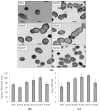Absence of Streptococcus pneumoniae Capsule Increases Bacterial Binding, Persistence, and Inflammation in Corneal Infection
- PMID: 35456761
- PMCID: PMC9025271
- DOI: 10.3390/microorganisms10040710
Absence of Streptococcus pneumoniae Capsule Increases Bacterial Binding, Persistence, and Inflammation in Corneal Infection
Abstract
The role of the pneumococcal polysaccharide capsule is largely unclear for Streptococcus pneumoniae keratitis, an ocular inflammatory disease that develops as a result of bacterial infection of the cornea. In this study, capsule-deficient strains were compared to isogenic parent strains in their ability to adhere to human corneal epithelial cells. One isogenic pair was further used in topical ocular infection of mice to assess the contribution of the capsule to keratitis. The results showed that non-encapsulated pneumococci were significantly more adherent to cells, persisted in significantly higher numbers on mouse corneas in vivo, and caused significant increases in murine ocular IL9, IL10, IL12-p70, MIG, and MIP-1-gamma compared to encapsulated S. pneumoniae. These findings indicate that the bacterial capsule impedes virulence and the absence of capsule impacts inflammation following corneal infection.
Keywords: Streptococcus pneumoniae; adhesion; capsule; inflammation; ocular; pneumococcus.
Conflict of interest statement
The authors declare no conflict of interest.
Figures





References
-
- Carvalho M.G., Steigerwalt A.G., Thompson T., Jackson D., Facklam R.R. Confirmation of nontypeable Streptococcus pneumoniae-like organisms isolated from outbreaks of epidemic conjunctivitis as Streptococcus pneumoniae. J. Clin. Microbiol. 2003;41:4415–4417. doi: 10.1128/JCM.41.9.4415-4417.2003. - DOI - PMC - PubMed
LinkOut - more resources
Full Text Sources
Research Materials

